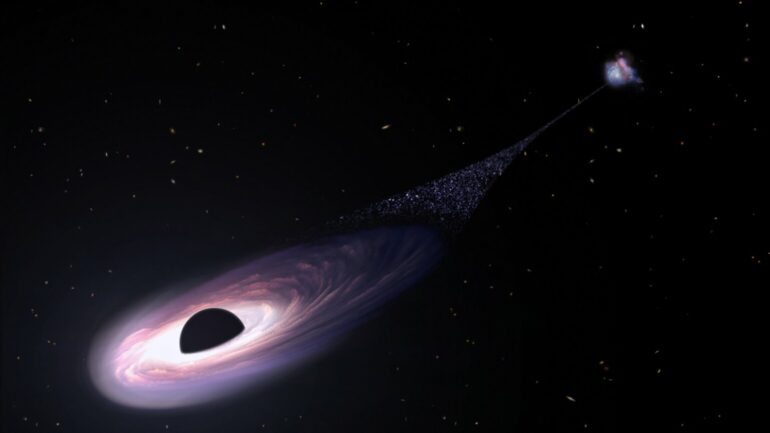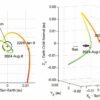Astronomers have spotted a candidate supermassive black hole running away from its home galaxy, hurtling through space at a velocity of about 4 million miles per hour for the past 39 million years.
A Yale University-led team using NASA’s Hubble Space Telescope and W. M. Keck Observatory on Maunakea in Hawaiʻi discovered an unusual, very thin, almost straight streak of young stars and shocked gas—possibly the trail the black hole left behind as it escaped.
The findings are outlined in a study published in The Astrophysical Journal Letters.
“Something like this has never been seen anywhere in the universe,” said Pieter van Dokkum, professor of astronomy and physics at Yale University and lead author of the study. “We’ve known for a long time that supermassive black holes exist and it had been predicted for about 50 years that they could sometimes be ejected from galaxies. If confirmed, this would be the first evidence of a runaway supermassive black hole, proving this prediction.”
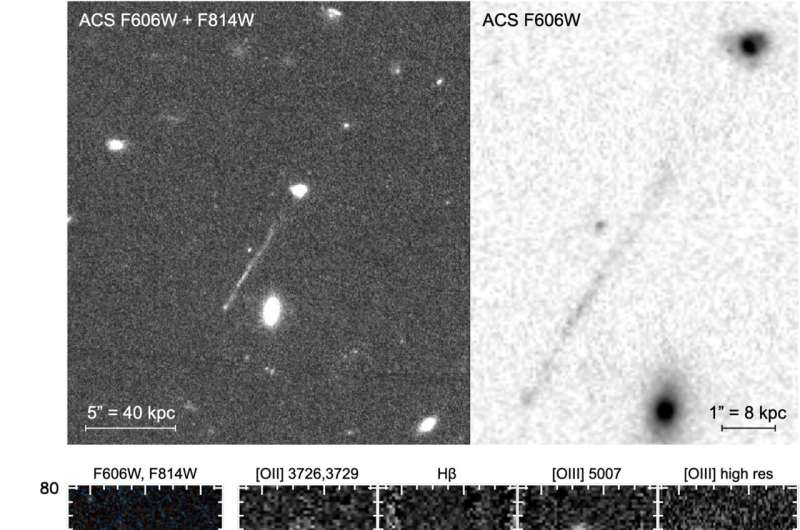
Top left: F606W + F814W HST/ACS image of the linear feature and its surroundings. Top right: zoomed view of the F606W image. The feature shows a compact bright spot at the narrow tip and seems to broaden toward the galaxy. Bottom left: color image, generated from the F606W and F814W images. Bottom right panels: sections of LRIS spectra near bright emission lines. The feature and the galaxy are at the same redshift. The kinematics and line strengths show complex variations along the feature. © The Astrophysical Journal Letters (2023). DOI: 10.3847/2041-8213/acba86
Van Dokkum’s team first detected the long feature with NASA’s Hubble Space Telescope. To get a closer look, they conducted follow-up observations using Keck Observatory’s Low Resolution Imaging Spectrometer (LRIS) and Near Infrared Echellette Spectrograph (NIRES).
The Keck Observatory data revealed the streak of stars measured a remarkable 200,000 light-years in length and extended from a compact, active star-forming galaxy whose light took about 7.6 billion years to reach Earth. The trail is almost half as bright as the host galaxy it is linked to, indicating it contains an abundance of new stars.
“We think we’re seeing a wake behind the black hole where the gas cools and is able to form stars. So, we’re looking at star formation trailing the black hole,” said van Dokkum. “What we’re seeing is the aftermath. Like the wake behind a ship, we’re seeing the wake behind the black hole.”
Keck Observatory also showed a bright knot of ionized gas at the top of the wake—likely the site of the black hole itself. Also, the linear feature’s home galaxy appears to be missing a black hole at its center, or at least does not have one that is actively feasting on material and generating powerful jets of energy that telescopes can detect.
If the narrow wake of stars and gas was indeed created by a black hole dislodged from its home galaxy, astronomers have a likely explanation for its origin story. First, two galaxies, both containing a supermassive black hole inside their cores, merge. Next, as the black holes whiz around each other in a binary dance at the center of the newly- merged galaxy, a third supermassive black hole inside another galaxy intrudes on the couple. The trio’s interaction with one another then creates an unstable situation that generates enough velocity to torpedo one of the three black holes out.
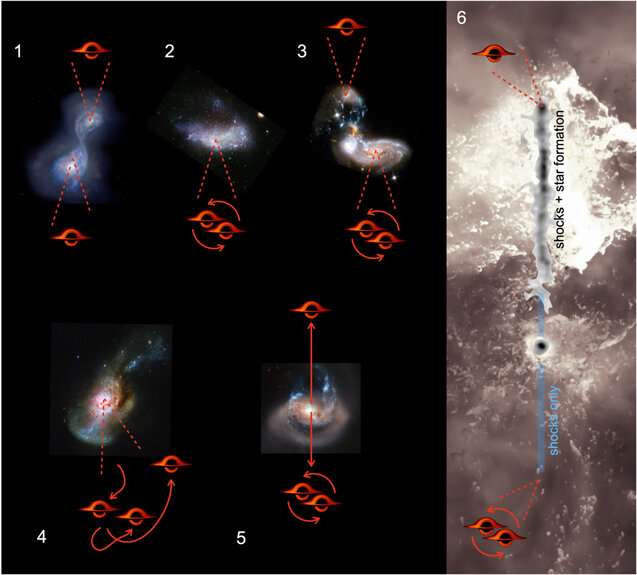
Schematic illustration of the runaway SMBH scenario as an explanation of the key observed features. Panels 1–5 show a “classical” slingshot scenario (e.g., Saslaw et al. 1974). First, a merger leads to the formation of a long-lived binary SMBH (1,2). Then a third galaxy comes in (3), its SMBH sinks to the center of the new merger remnant, and this leads to a three-body interaction (4). One black hole (usually the lightest) becomes unbound from the other two and receives a large velocity kick. Conservation of linear momentum implies that the remaining binary gets a smaller velocity kick in the opposite direction. If the kicks are large enough all SMBHs can leave the galaxy (5). There can be ≳1 Gyr between the events in panels (2) and (3). Panels (4) and (5) happened ∼40 Myr before the epoch of observation. The background of (6) is a frame from an Illustris TNG simulation (Pillepich et al. 2018), with lighter regions having higher gas density. This illustrates that there can be highly asymmetric flows in the circumgalactic medium, and we speculate that the SMBH at A is traveling through such a region of relatively dense and cold CGM (see text). Credit for the image in the top left panel: NAOJ. © The Astrophysical Journal Letters (2023). DOI: 10.3847/2041-8213/acba86
As a next step, van Dokkum and his team are now seeking to confirm whether their discovery is in fact a runaway black hole; they’ve applied for time on NASA’s James Webb Space Telescope and Chandra X-ray Observatory to conduct follow-up observations.
Because the linear streak of newborn stars and shocked gas is so striking, van Dokkum says it should be straightforward to find other objects like it in current and future data, such as with NASA’s upcoming Nancy Grace Roman Space Telescope.
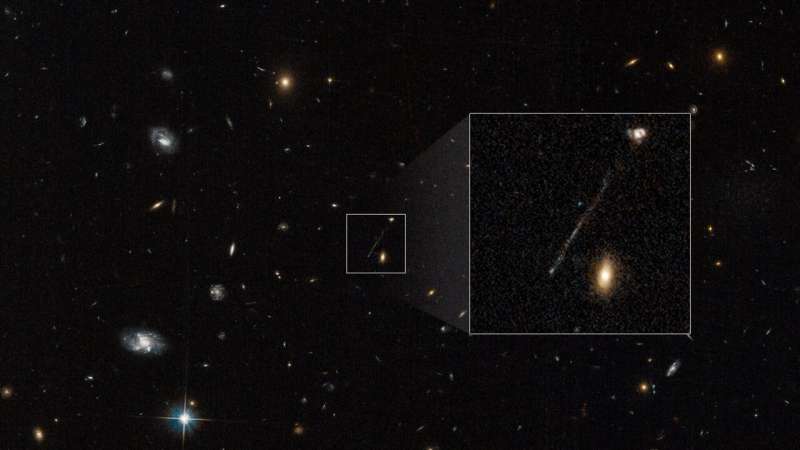
This Hubble Space Telescope archival photo captures a curious linear feature that is so unusual it was first dismissed as an imaging artifact from Hubble’s cameras. But follow-up spectroscopic observations reveal it is a 200,000-light-year-long chain of young blue stars. A supermassive black hole lies at the tip of the bridge at lower left. The black hole was ejected from the galaxy at upper right. It compressed gas in its wake to leave a long trail of young blue stars. Nothing like this has ever been seen before in the universe. This unusual event happened when the universe was approximately half its current age. © NASA, ESA, Pieter van Dokkum (Yale); Image Processing: Joseph DePasquale (STScI)
“Much of what we do is hypothesis testing, or refining previous measurements, but sometimes there is this bolt out of the blue of a completely unanticipated discovery. That is rare, but it is the best!” said van Dokkum.
“Going from noticing the streak and thinking ʻhey that’s weird’ to this paper was so incredibly fun and satisfying as we were all learning every step of the way,” said co-author Imad Pasha, a Yale University graduate student on van Dokkum’s research team.
More information:
Pieter van Dokkum et al, A Candidate Runaway Supermassive Black Hole Identified by Shocks and Star Formation in its Wake, The Astrophysical Journal Letters (2023). DOI: 10.3847/2041-8213/acba86
Provided by
W. M. Keck Observatory
Citation:
A strange streak of young stars is evidence of a runaway supermassive black hole, study finds (2023, April 6)
